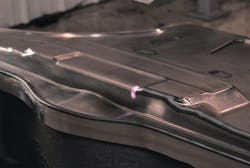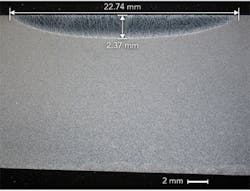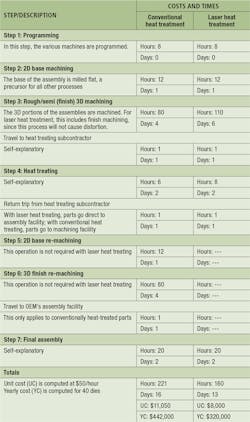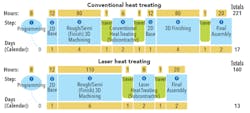Laser method also demonstrates cost savings for OEMs
ARAVIND JONNALAGADDA, MARCUS STACKPOOLE, and MATTHEW STACKPOOLE
Automotive die original equipment manufacturers (OEMs) throughout Europe are delivering dies faster, with superior quality, and at lower cost than U.S. OEMs are when they deliver the exact same automotive dies. The reason for this is laser heat treatment (FIGURE 1)—a process that has become near-mainstream in Europe, yet is barely practiced in the U.S.
FIGURE 1. Laser heat treatment of a cowl side automotive stamping die is shown in action.
Laser heat treatment’s adoption in Europe has been universally successful and the adoption of this technology by U.S. OEMs is inevitable. Barriers to adoption of laser heat treatment among U.S. automotive die OEMs include the fact that this technology is still not well understood in the U.S.; that data on laser heat treatment’s cost savings, quality, and schedule improvements have not yet migrated to U.S. decision-makers; and that there is a scarcity of reliable laser heat treatment job shops in the U.S. But clearly, laser heat treatment is poised for rapid adoption in the U.S. OEM community.
This article presents a basic technical introduction to laser heat treatment and shares the results of a case study on the cost savings in automotive trimming/form dies.
What is laser heat treatment?
Laser heat treatment is a process in which a laser beam, with a typical spot size between 0.5 × 0.5 in. and 2 × 2 in., illuminates the surface of a metal part as a means of delivering heat to it. The laser energy is delivered in such a way as to raise the temperature of the metal’s surface and heat-affected zone (HAZ) above its metallurgical transformation temperature. When the laser heat source is removed, the thermal mass of the metal provides rapid quenching of the heated area by conductive heat removal, resulting in the desired hardness. The details of the laser beam’s operation can be fine-tuned so as to exert precise control over all aspects of the hardening process. Depending on geometry, laser heat treatment also allows treatment via line-of-sight for areas that are difficult to reach by other means. Laser heat treatment is sometimes also referred to as laser hardening.
Benefits of laser heat treatment
Compared to conventional heat treatment techniques, such as induction, furnace, and flame heat treatment, laser heat treatment’s benefits are:
Consistent hardness depth. By allowing precise control of the delivery of energy to the metal itself, including millisecond-level feedback control, the characteristics of laser energy mean that laser heat treatment can produce a HAZ with exacting specifications, leading to consistent hardness depth within very tight tolerances.
No hard milling is required on most automotive dies. In addition to the precise control mentioned previously, the inherent characteristics of laser energy itself mean that laser heat treatment automatically delivers the smallest possible total energy to the die under treatment for any given HAZ size. This built-in feature of the process automatically results in zero distortion in most automotive dies. Unlike conventional heat-treating methods that require additional stock material to be milled after heat treatment, laser heat treatment is performed after the die is cut to final form. This results in cost savings from avoiding additional machining operations while the material is hard.
Higher hardness. Due to rapid self-quenching of a heat-treated area in laser heat treatment, under the right process conditions, the typical hardness achieved by the process tends to be a few points higher than flame or induction processes.
Precise application of beam energy to the work spot. Flames or coils need not be in close proximity to the work area, resulting in greater ability to apply heat only to the intended area, with minimal to zero heating of adjoining areas.
Laser heat-treatable materials
Any steel with carbon content of 0.2% or greater is heat-treatable (FIGURE 2). In general, the hardness of the laser heat-treated dies is comparable to, or better than, the hardness achieved by the use of conventional techniques.
FIGURE 2. A metallurgical cross-section of a laser heat-treated die in S7140 alloyed steel is shown.
A few of the common laser-treatable materials for automotive applications include:
- D6510 ductile iron
- S7140 alloyed steel
- G2500 gray cast iron
- G25HP gray cast iron
- G3500 gray iron
- D4512 ductile iron
- S0030 non-alloyed steel
- S0050A alloyed steel
- A2 tool steel
- D2 tool steel
- S7 tool steel
- M2 tool steel
- 4140 alloy steel
- 4340 alloy steel
Cost savings
Cost savings from laser heat treatment in the fabrication and maintenance of automotive dies results primarily from the elimination of post-hardening dimensional restoration processes. To illustrate the potential for laser heat treatment, consider the following case study from the from one of the local OEM die suppliers.
FIGURE 3. An example of automotive trim die used by the OEM supplier is shown; this die measures 177 × 95 × 54 in. and weighs 93,000 lbs.
This study concerns new part manufacture of automotive trim/form dies. A mid-sized OEM typically produces 40–100 such dies in the year. The weight of the dies ranges from 8000 to 95,000 lbs (FIGURE 3). For this process, both Cost in Hours while the product was being worked on and the Calendar Days for each step were measured for a midsize trim die weighing approximately 42,000 lbs. FIGURE 4 shows the results in summary form, while the TABLE details them.
FIGURE 4 also indicates various steps involved in the die manufacturing. The dies produced using conventional heat-treating methods such as induction and flame are rough-machined, leaving additional stock material up to 0.020 in. to account for the distortion caused due to the heat treatment process. The heat-treated die is then hard-milled to the final dimensions. Cutting a hard material takes substantially longer and requires much more expensive tooling. For simplicity, this case study did not account for additional tooling expenditure required for hard milling operation.
FIGURE 4. This schematic shows the various steps involved in die manufacturing.
Laser heat treatment, on the other hand, obviates post-heat treatment machining and associated steps, thereby reducing the cost and overall time for production.
Results summary
The use of laser heat treatment reduced the yearly cost for this product line from $442,000 to $320,000, for a savings of 27.6%. Delivery time was reduced from 17 days to 13 days—a net speedup of 23.5%. Further savings through reduced tooling expenditure was expected. Total energy usage was reduced by an amount not computed here, that may have future savings if carbon credits become a part of the financial landscape.
ARAVIND JONNALAGADDA([email protected]) is the Technical Director, MARCUS STACKPOOLE is CEO, and MATTHEW STACKPOOLE is R&D Manager, all at Synergy Additive Manufacturing LLC, Clinton Township, MI; https://synergyadditive.com.





